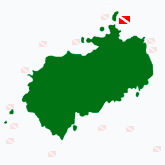Cocos Liveaboard - The Itinerary
Here you find the detailed itinerary of our Cocos Diving Liveaboard and more information about the different dive site we are visiting.
Among Cocos Island’s many attribute is a startling degree of biodiversity. This Island’s world-renowned waters explode with life, including innumerable white tip reef sharks, schooling hammerhead sharks, dolphins, mantas and marbled rays, giant moray eels, sailfish, and of course the occasional whale shark. Other common encounters are large schools of jacks and tuna, silky sharks, silvertip sharks, marlin, Creole fish, green turtles, and octopus.
Cocos Island is also home to at least 27 endemic fish species including the exotic rosy-lipped batfish. The terrestrial life at Cocos also exhibits a high number of endemic species. Here are found some 70 of the 235 identified vascular plant species in the world, some 25 species of moss, 27 species of liverwort and 85 species of fungus. There are upwards of 87 bird species, including the famous Cocos Island cuckoo, finch and flycatcher. There are 362 species of insects, of which 64 are endemic. Two native reptiles are found only on the Island.
Beneath the waterfalls and in the rivers, are freshwater fish that mystify scientists by their very existence. Because of its remote location and abundance of freshwater, Cocos has, throughout history, been a favourite re-supply station for pirates, whalers and sailors.
Itinerary

Many kinds of dives on offer, ranging from vertical walls, drifts, pinnacles, as well as incredible marine life, including hammerhead sharks, sailfish, and whale sharks.
Spent diving the pinnacles around the perimeter of Cocos Island. Divers usually average three dives per day at depths of 60-100ft (18-30m) or more. This, of course, is what the whole trip is about.
The dive adventure starts and ends in San Jose (ship will leave from Puntarenas). We will stay 11 days/10 nights on the ship and explore the magical world of Cocos Island.
Arrival Day

You must arrive at least one day prior to the boat departure date.
Upon arrival to San José, we can have transportation waiting for you (please contact us for a quote) or you can take a taxi to your hotel. There are always taxis available at the airport, even minivans for those of you who carry a lot of gear. We can also recommend and arrange accommodations for hotels in San José. Please note that we do not pick up from all San Jose hotels.
The evening before boat departure, an Undersea Hunter representative will fax you to confirm your pick up time the next day. The evening is at your leisure. Air transport, airport transfers, hotel nights and meals before and after the cruise are not included in the charter.
Day 1

The following day, generally between 8 AM and 1 PM we pick up from certain hotels and transfer everybody by bus to Puntarenas where you will board the vessel. The drive takes about 2 1/2 hours, and gives you a chance to view the lush forest and rich farmland of the region.
Due to occasional low tides our boats may need to depart from the pier earlier in the day. Should this occur, you will be transferred by skiff to the vessel. When all passengers have arrived on board, the vessel will take a 32-36 hour cruise out to Cocos Island.
Day 2

A travel day. There will be time to arrange dive and camera gear as well as enjoy the Pacific and the sunshine. The Galapagos Shark Diving Team will give you some more insights about their shark work and is happy to answer your questions. Also, the group of incredibly experienced divers provides plenty of stories to pass the time. There are videos and the experience of the Captain and crew to help you get excited for the diving. In addition, you may want to take this time to take one of our diving courses.
Day 3 - 8

Spent diving the pinnacles around the perimeter of Cocos Island. Divers usually average three dives per day at depths of 60-100 feet (18-30 meters) or more. This, of course, is what the whole trip is about.
Day 9
Day 10

This day is a travel day. Time to share photos, watch videos and exchange contacts. All day to discuss the diving and to compare your adventures!
Day 11

Arrival to Puntarenas. Immediately after breakfast you will be transported back to San Jose. We strongly recommend staying one more night on land, before flying out, in case of any unforeseen delays.
Optional tours

While you are here in Costa Rica it is certainly worth the extra time to visit other aspects of the country that truly make it a natural wonderland. Very active volcanoes, white water rafting, mountain biking, some of the most pristine jungles in the world, coffee plantations, horseback riding, visits to craft centres, and of course, some of the most beautiful beaches in the world are among the activities and destinations available in the country. We would be happy to arrange one day tours or longer trips to more remote areas at the client´s request. Recommended Costa Rican companies will operate these tours.
Dive spots in detail
Manuelita Coral Garden

Depth:
20 - 70 ft. / 6 - 21 m.
Your first Cocos dive and one of our favourites is Manuelita Island inside, which faces the calm waters of Chatham Bay. This well-protected site receives little current or swells. These calm conditions support a beautiful shallow garden at depths ranging from 20 to 70 feet. It is a macro-photographers heaven.
Countless fish, eels, lobsters and many other critters are residents of the hard coral reef and the adjacent sand slope. Large fish are frequent visitors to this site, including hammerheads, black tip sharks, white tip sharks and numerous marble rays.
Marine life:
Whitetips, marble rays, manta rays, eagle rays, turtles, black tips, garden eels and the most recent addition: Tigers Sharks!
Manuelita Outside

Depth:
60 - 130 ft. / 18 - 39 m.
Several cleaning stations are the main attraction of the ocean side of Manuelita. A gradually descending slope, it contains huge boulders where divers can easily hide to watch the hammerheads be approached by cleaner fish. Most of the action takes place between 60 and 130 feet.
Marine life:
Hammerheads, black tips, white tips, eagle rays, manta rays, yellow fin tunas, turtles, jacks, and whale sharks.
Viking Rock

Depth:
50 - 130 ft. / 15 - 39 m.
This is a small helmet-shaped island on the northwest corner of Wafer Bay. A vertical wall leading to large step-like surfaces creates a variety of habitats where one can see both small creatures and large pelagic species.
Marine life:
Hammerheads, white tips, eagle rays, turtles, and we have been spotting Tiger sharks here as well.
Dirty Rock

Depth:
20 - 130 ft. / 6 - 39 m.
Dirty Rock is one of the main reasons why divers keep coming back to Cocos. One of Cocos Island's most spectacular rock formations where vast amounts of very diverse creatures generate the most dynamic dives one can imagine.
Marine life:
Hammerheads, white tips, black tips, marble rays, eagle rays, mobula rays, jacks, turtles, dolphins, and whale sharks.
Punta Maria

Depth:
80 - 120 ft. / 24 - 36 m.
Punta Maria is a seamount that rises from a deep sandy area up to 90 feet on the main rock and with two pinnacles reaching up to 65 and 75 feet below the surface, which can only be visited when the current permits. It has a cleaning station for hammerheads as well as galapagos sharks.
Marine life:
Hammerheads, Galapagos sharks, whitetip reef sharks, blacktip sharks, marble rays, octopus, and eels.
Big Dos Amigos

Depth:
60 - 120 ft. / 18 - 36 m.
Dos Amigos Grande is the largest rock on the exposed southern side of Cocos Island. A majestic arch going from 70 feet to a sandy bottom at 110 feet is the main attraction of this site. The arch is a wonderful shelter for a great number of lobsters, snappers and many colourful creatures. Bring your underwater lights as you would not want to miss any of this sites beautiful secrets.
Marine life:
White tips, marble rays, hammerheads, mobula rays
Small Dos Amigos

Depth:
60 - 120 ft. / 18 - 36 m.
The southernmost part of the island, Dos Amigos Pequeno, is not always accessible during the rainy season due to the rough surge around this exposed site. When accessible it is well worth the visit because this is where the open sea current first reaches the island, bringing with it exciting surprises.
Marine life:
Hammerheads, white tips, mobula rays, eagle rays, whale sharks, dolphins, silkies, dolphins
Bajo Dos Amigos

Depth:
90 - 130 ft. / 27 - 39 m.
Bajo Dos Amigos is a seamount shaped like a king's crown; this is the only place where black coral colonies can be watched at safe depths, between 100 and 130 feet. Definitely not an easy place to dive, due to the strong currents normally present on this site, we will only visit here during the dry season.
Marine life:
Hammerheads, mobula rays, manta rays, eagle rays, sailfish, wahoos, black coral
Shark Fin Rock

Depth:
40 - 130 ft. / 12 - 39 m.
From the surface, this pyramidal rock looks exactly like its name, shark fin. This beautiful site hosts a huge school of thousands of bigeye jacks and is the home of an active colony of friendly marble rays. Because of the heavy surge often present on the spot, Shark Fin can only be safely dived between 40 and 120 ft.
Marine life:
Marble rays, white tips, mobula rays, eagle rays, dolphins
Bait Ball

Depth:
0 - 20 ft. / 0 - 6 m.
This phenomenon occurs when the little bait fish, upon being hunted, seek protection by forming a furiously spinning silvery ball. This is an attempt of a small species to intimidate and confuse a predator. In a bait ball you can find different bait fish and different hunters. Sometimes the bait fish will be trapped between the surface and the hunters below. This is when the boobies and frigate birds will join the feast. These special events can happen anywhere and at anytime.
Marine life:
Green jacks, yellowtail grunts, rainbow runner, silky sharks, blacktip sharks, dolphins and tunas
Submerged Rock

Depth:
20 - 110 ft. / 6 - 33 m.
Swimming through this splendid arched hole, you will find colorful scenery creating unique photo opportunities at depths between 50 to 70 feet. This pinnacle serves as a nursery for white tip sharks, where one can always see pregnant females and tiny babies.
Marine life:
White tips, black tips, mobula rays, hammerheads, marble rays
Bajo Alcyone

Depth:
90 - 120 ft. / 27 - 36 m.
This legendary seamount is probably one of the most incredible dive sites in the world. No words can describe what you will see at Alcyone. Just come and witness it for yourself.
Marine life:
Hammerheads, white tips, black tips, whale sharks, marble rays, eagle rays, mobula rays, manta rays, turtles, yellow fin tuna, silkies, sailfish, wahoos, dolphins
Silverado

Depth:
30 - 40 ft. / 10 - 12 m.
Silverado is the only cleaning station for silvertip sharks at Cocos Island that we currently know about.
Marine life:
Silvertips
Lobster Rock

Depth:
40 - 110 ft. / 12 - 33 m.
On this finger-like rock, divers can easily approach large white tips lying on the bottom in great numbers. In the deep sandy area surrounding it, the elusive rosy-lipped batfish can be found between 90 and 120 feet.
Marine life:
White tips, marble rays, manta rays, eagle rays, red lip batfish, frogfish, garden eels




















































